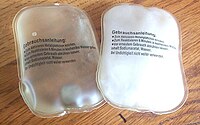
Photo from wikipedia
Residential and commercial buildings consume nearly 40 percent of total USA energy use and account for one-third of total greenhouse gas emissions. The challenges are how to effectively promote energy… Click to show full abstract
Residential and commercial buildings consume nearly 40 percent of total USA energy use and account for one-third of total greenhouse gas emissions. The challenges are how to effectively promote energy efficiency in buildings to respond to the high financial burden of energy consumption, while reducing pollution. Phase change materials (PCMs) have been used as passive energy storage for building systems. Along this vein, this study aims to numerically elucidate the design parameters of building envelopes strengthened by PCM layers, and unveil their impacts on building energy efficiency. Critical design variables, such as the thickness of the PCM layer, the latent heat of PCMs, or melting temperature of PCMs were selected for a parametric study, while performance metrics were used to assess building efficiency. Results revealed that PCM-enabled building walls exhibited different levels of improvement, in terms of reduction of peak temperature and temperature swings. Among the variables, the selection of the proper melting point for a PCM was identified as the most crucial parameter for determining building energy efficiency, while the heat of fusion was also observed as a critical property of PCM for building potential. Findings also demonstrated that the placement of the PCM near the interior wall surface could achieve higher efficiency, as compared to other cases. Results also showed that the thermal conductivity of PCM has a minimum contribution to energy storage capacity.
Journal Title: Sustainability
Year Published: 2018
Link to full text (if available)
Share on Social Media: Sign Up to like & get
recommendations!